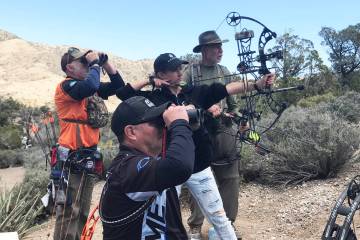There’s more to Rocky Mountain Elk Foundation than antlers and expos
With Christmas Day less than two weeks away, my guess is that for many of you outdoor types walking the aisles at retail stores — real or virtual — is probably wearing a little thin about now. So why not try something different? If only for a change of pace.
When the National Finals Rodeo comes to town, so too does the Rocky Mountain Elk Foundation with its Hunter Outdoor Christmas Expo. Promoted as a celebration of “hunting, the outdoors and the Western lifestyle,” the event is slated to run through Saturday in the South Halls of the Las Vegas Convention Center. The event is free to the public and open from 9 a.m. to 5 p.m. each day.
Among the list of exhibitors whose wares include firearms, optics, footwear, miscellaneous outdoor gear, trailers and western items, you also will find the RMEF Great Elk Tour. That’s a collection of bulls that are selected for display based on their size, uniqueness and back story. Bulls displayed in the collection are changed out each year and most have been harvested on public land.
While it is always fun to see big bulls and their headgear, there is more to the RMEF than expos and antlers. Founded in 1984 by four hunters from Montana, the RMEF has since become one of America’s largest conservation organizations. Though its primary focus is elk and their habitat, the Foundation’s conservation efforts help multiple other species as well.
How does the RMEF accomplish its conservation mission? By focusing on three areas: land protection, habitat stewardship and elk restoration.
According to the RMEF website, it “permanently protects crucial elk winter and summer ranges, migration corridors, calving grounds and other vital areas, while focusing on securing and improving hunter access throughout elk country. Our land conservation tools include: acquisitions, access agreements and easements, conservation easements, land and real estate donations, land exchanges and associated acres.”
Through fundraising efforts of its more than 500 chapters nationwide, the RMEF has been able to finance the protection and enhancement of more than 7.4 million acres of elk habitat. Moreover, the Foundation also has been able to open more than 1.2 million acres of elk habitat in 16 states to public hunting and other outdoor recreation. Its goal is to open or improve access to 50,000 acres of land every year for five years.
While we tend to think of elk as a species of the West, RMEF has helped to restore the Wapiti to states much further east: Kentucky, Missouri, North Carolina, Ontario, Tennessee, Virginia, West Virginia and Wisconsin. Historically, elk were once found throughout most of what is now the United States and parts of Canada.
In addition to its conservation activities, the RMEF also is involved in outreach efforts designed to promote the hunting heritage and increase youth participation.
Here in the Silver State, “RMEF and its partners have completed 250 conservation and hunting heritage outreach projects with a combined value of more than $19.2 million,” states the Foundation’s December 2018 Project History Summary. “These projects have protected or enhanced 289,544 acres of habitat and have opened or secured public access to 30,625 acres.”
In 2019, members of REF chapters in Nevada have been rather productive, said Les Smith, RMEF regional director for Nevada. “This year we set records both in how much money we had available to use in the state, and also how much money we raised in the state this year. So, we’re going to have a banner year next year.”
Already on the schedule for 2020 are two conservation projects in remote corners of Nevada. One of those is slated for north Cave Valley, where the Bureau of Land Management has identified 2,600 acres of land for removal of pinyon pine and juniper trees. This project will help to improve the health of the sagebrush vegetation community. The total cost is projected at $110,000, with $30,000 of that coming from the RMEF.
Elk use the affected areas is in the summer months, but in the right conditions may use it year-round. The other project will focus on habitat restoration in the South Mountains along the Utah state line.
Freelance writer Doug Nielsen is a conservation educator for the Nevada Department of Wildlife. His “In the Outdoors” column, published Thursday, is not affiliated with or endorsed by the NDOW. Any opinions he states in his column are his own. Find him on Facebook at @dougwritesoutdoors. He can be reached at intheoutdoorslv@gmail.com


















